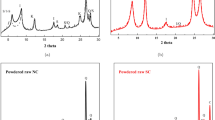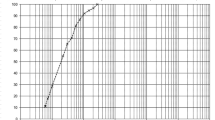Abstract
Advances in additive manufacturing create unique opportunities for the investigation of permeability of fine-grained soils. The permeability of fine-grained soils, such as clays, plays an important role in various design considerations in the geotechnical, environmental, and stormwater management systems. This research investigates the application of 3D printed specimens in studying the hydraulic and mechanical properties of clayey soils. The effects of 3D printing, specifically direct binder jet printing, on the permeability, and other physical properties of clay were investigated. Cylindrical clay specimens were prepared using an advanced direct binder jet printing and tested in a flexible wall permeameter and triaxial compression setup under effective confining stresses representing clay at very shallow depths. The results of this study show that the 3D printing process affects the permeability of clay through changes in physical properties such as the specific surface area. However, the printing provides consistent and repeatable specimens with very low disturbance and efficient controlled geometry. Also, due to stiffer 3D printed specimen, less confinement impact was observed in 3D printed specimens. Also, 3D printed specimens showed significantly higher shear strength and friction angle. The outcome of this research could pave the path for future studies dealing with flow through fractured clays.
Article Highlights
-
3D printing and sintering change the physical properties of clay powder leading to higher permeability.
-
The impact of confining pressure on 3D printed specimens is considerably low.
-
3D printing increases the shear strength of soil specimens.











Similar content being viewed by others
Data Availability
Most of the data and models generated or used during the study appear in the submitted article. However, some or all data used are available from the corresponding author by request.
References
ASTM D2487-17e1: Standard practice for classification of soils for engineering purposes (Unified Soil Classification System). ASTM International (2020).
Basak, P.: Non-Darcy flow and its implications to seepage problems. J. Irrig. Drain. Div. 103(4), 459–473 (1977)
Bockhorn, B., Klint, K.E.S., Locatelli, L., Park, Y.-J., Binning, P.J., Sudicky, E., Jensen, M.B.: Factors affecting the hydraulic performance of infiltration based SUDS in clay. Urban Water J. 14(2), 125–133 (2017). https://doi.org/10.1080/1573062x.2015.1076860.
Chan, S.S.L., Pennings, R.M., Edwards, L., Franks, G.V.: 3D printing of clay for decorative architectural applications: Effect of solids volume fraction on rheology and printability. Additive Manufact. 35(April), 101335 (2020). https://doi.org/10.1016/j.addma.2020.101335
Chapuis, R.P.: Similarity of internal stability criteria for granular soils. Can. Geotech. J. 29(4), 711–713 (1992). https://doi.org/10.1139/t92-078
Chapuis, R.P.: Predicting the saturated hydraulic conductivity of soils: a review. Bull. Eng. Geol. Env. 71(3), 401–434 (2012). https://doi.org/10.1007/s10064-012-0418-7
Chapuis, R.P., Aubertin, M.: On the use of the Kozeny–Carman equation to predict the hydraulic conductivity of soils. Can. Geotechn. J. 40(3), 616–628 (2003). https://doi.org/10.1139/t03-013.
Chapuis, R.P., Legare, P.-P.: A simple method for determining the surface area of fine aggregates and fillers in bituminous mixtures. ASTM Testing and Materials. ASTM STP 1147. ASTM, West Conshohocken, pp 177–186 (1992).
Chen, Z., Li, Z., Li, J., Liu, C., Lao, C., Fu, Y., Liu, C., Li, Y., He, Y.: 3D Printing of ceramics: a review. J. Eur. Ceram. Soc. 39(4), 661–687 (2019). https://doi.org/10.1016/j.jeurceramsoc.2018.11.013
Chen, J., Tong, H., Yuan, J., Fang, Y., Gu, R.: Permeability prediction model modified on Kozeny-Carman for building foundation of clay soil. Buildings. 12(11), 1798 (2022). https://doi.org/10.3390/buildings12111798
Clennell, M.B., Dewhurst, D.N., Brown, K.M., Westbrook, G.K.: Permeability anisotropy of consolidated clays. Geol. Soc. Spec. Publ. 158, 79–96 (1999). https://doi.org/10.1144/GSL.SP.1999.158.01.07
Dananaj, I., Frankovska, J.: Permeability of fine-grained Soils. Slovak Geol. Magaz 10(14), 3025–3312 (2004)
Das, B. M., Sivakugan, N.: Principles of foundation engineering. 8th ed., Cengage Learning (2017).
Dejam, M., Hassanzadeh, H., Chen, Z.: Pre-Darcy flow in porous media. Water Resour. Res. 53(10), 8187–8210 (2017)
Dewhurst, D.N., Aplin, A.C., Sarda, J.P.: Influence of clay fraction on pore-scale properties and hydraulic conductivity of experimentally compacted mudstones. J. Geophys. Res. 104, 29261–29274 (1999)
Foth, H.D.: Fundamentals of soil science, 6th edn., p. 436. Wiley, New York (1978)
Fredlund, D.G., Xing, A., Huang, S.: Predicting the permeability function for unsaturated soil using the soil–water characteristic curve. Can. Geotech. J. 31, 533–546 (1994)
Gardner, W.R.: Some steady state solutions of the unsaturated moisture flow equation with application to evaporation from a water table. Soil Sci. 85(4), 228–232 (1958)
Gomez, J.S., Chalaturnyk, R.J., Zambrano-Narvaez, G.: Experimental investigation of the mechanical behavior and permeability of 3D printed sandstone analogues under triaxial conditions. Transp. Porous Media 129(2), 541–557 (2019). https://doi.org/10.1007/s11242-018-1177-0
Grunberger, D., DjCran, I., Velde, B., Tessier, D.: Measurement through direct observation of kaoline particle orientation during compaction. C.R. Acad. Sci. Paris 318, 627–633 (1994)
Hanaor, D.A.H., Gan, Y.X., Revay, M., Airey, D.W., Einav, I.: 3D printable geomaterials. Geotechnique 66, 323–332 (2016). https://doi.org/10.1680/jgeot.15.P.034
Izbash, S.V.: O fl’tracii v krupnozernistom materiale [Seepage Through Coarse-grain materials]. NIIG, Leningrad (in Russian) (1931).
Jiang, L., Yoon, H., Bobet, A., Pyrak-Nolte, L.J.: Mineral fabric as a hidden variable in fracture formation in layered media. Sci. Rep. 10(1), 2020 (2020). https://doi.org/10.1038/s41598-020-58793-y
Klint, K.E., Gravesen, P.: Fractures and Biopores in Weichselian Clayey till Aquitards at Flakkebjerg, Denmark. Hydrol. Res. 30(4–5), 267–284 (1999). https://doi.org/10.2166/nh.1999.0015
Klosek-Wawrzyn, E., Malolepszy, J., Murzyn, P.: Sintering behavior of 533 kaolin with calcite. Proc. Eng. 57, 572–582 (2013). https://doi.org/10.1016/j.proeng.2013.04.073
Kozlowski, T., Ludynia, A.: Permeability coefficient of low permeable soils as a single-variable function of soil parameter. Water 11(12), 2500 (2019). https://doi.org/10.3390/w11122500
Li, L., Ma, W.: Experimental study on the effective particle diameter of a packed bed with non-spherical particles. Transp. Porous Media 89(1), 35–48 (2019). https://doi.org/10.1007/s11242-011-9757-2
Li, C.: Void ratio–permeability relations for clays. Quart. J. Eng. Geol. Hydrogeol. 53(2), 298–303 (2019). https://doi.org/10.1144/qjegh2018-158.
Liiv, J., Teppand, T., Rikmann, E., Tenno, T.: Novel eco-sustainable peat and oil shale ash-based 3D-printable composite material. Sustain. Mater. Technol. 17, e00067 (2018). https://doi.org/10.1016/j.susmat.2018.e00067
Lofrano, F.C., Morita, D.M., Kurokawa, F.A., de Souza, P.A.: New general maximum entropy model for flow through porous media. Transp. Porous Media 131, 681–703 (2020)
Loudon, A. G.: The computation of permeability from simple soil tests. Géotechnique. 3(4), 165–183 (1952). https://doi.org/10.1680/geot.1952.3.4.165.
Mesri, G., Olson, R.E.: Mechanisms controlling the permeability of clays. Clays Clay Miner. 19, 151–158 (1971). https://doi.org/10.1346/CCMN.1971.0190303
Mitchell, J.K., Soga, K.: Fundamentals of Soil Behavior, 3rd edn. Wiley, Hoboken (2005)
Mualem, Y.: Hydraulic conductivity of unsaturated soils: Prediction and Formulas. In: A. Klute, ed.,Methods of Soil Analysis. Part I. Physical and Mineralogical Methods, 2nd ed. Agronomy Monograph No. 9, American Society of Agronomy, Madison, pp. 799–823 (1986).
Panda, B., Chandra, P.S., Jen Tan, M.: Anisotropic mechanical performance of 3D printed fiber reinforced sustainable construction material. Mater. Lett. 209, 146–149 (2017). https://doi.org/10.1016/j.matlet.2017.07.123
Pap, M., Mahler, A.: Comparison of different empirical correlations to estimate permeability coefficient of quaternary Danube soils. Periodica Polytechn. Civil Eng. (2018). https://doi.org/10.3311/ppci.13108
Revelo, C.F., Colorado, H.A.: 3D printing of kaolinite clay ceramics using the Direct Ink Writing (DIW) technique. Ceram. Int. 44(5), 5673–5682 (2018). https://doi.org/10.1016/j.ceramint.2017.12.219
Samarasinghe, A.M., Huang, Y.H., Drnevich, V.: Permeability and consolidation of normally consolidated soils. J. Geotech. Eng. Div. 108(6), 835–850 (1982). https://doi.org/10.1061/ajgeb6.0001305
Tay, Y.W.D., Panda, B., Paul, S.C., Noor Mohamed, N.A., Tan, M.J., Leong, K.F.: 3D printing trends in building and construction industry: a review. Virtual Phys.Prototyping 12(3), 261–276 (2017). https://doi.org/10.1080/17452759.2017.1326724
Taylor, D.W.: Fundamentals of Soil Mechanics. Chapman and Hall: London (1948)
Terzaghi, K.: Principles of soil mechanics I—Phenomena of cohesion of clays. Eng. News-Record 95(19), 742–746 (1952)
Tethan. Tethonite. Retrieved from https://tethon3d.com/wp-content/uploads/Tethonite.pdf (2022)
van Genuchten, M.T.: A closed form equation for predicting the hydraulic conductivity of unsaturated soils. Soil Sci. Soc. Am. J. 44, 892–898 (1980)
Wei, D., Wang, Z., Pereira, J.-M., Gan, Y.: Permeability of uniformly graded 3D printed granular media. Geophys. Res. Lett. 48, e2020GL090728 (2021)https://doi.org/10.1029/2020GL090728
White, R. E.: Principles and practice of soil science : the soil as a natural resource, 4th ed. ISBN-13: 978-0-632-06455-7 (2006).
Acknowledgements
This research was made possible by the University of New Hampshire Collaborative Research Excellence (CoRE) initiative Fund, who we graciously thank for their funding and support. A special thanks to Hebatalla Ghoneim, Maya Norris, and Alex Rinn for their support in this research.
Funding
This work was partly supported by the University of New Hampshire Collaborative Research Excellence (CoRE) initiative Fund.
Author information
Authors and Affiliations
Contributions
Conceptualization was performed by MG, PN; methodology by MG, PN, MC, YW; formal analysis and investigation by MG, MC, and YW; writing—original draft preparation—by MC; writing—review and editing—by MG, PN, YW; funding acquisition by MG; resources by MG, PN; supervision by MG, PN; project administration by MG; data Curation by MC, MG.
Corresponding author
Ethics declarations
Conflict of interest
The authors have no relevant financial or non-financial interests to disclose.
Additional information
Publisher's Note
Springer Nature remains neutral with regard to jurisdictional claims in published maps and institutional affiliations.
Rights and permissions
Springer Nature or its licensor (e.g. a society or other partner) holds exclusive rights to this article under a publishing agreement with the author(s) or other rightsholder(s); author self-archiving of the accepted manuscript version of this article is solely governed by the terms of such publishing agreement and applicable law.
About this article
Cite this article
Carr, M.M., Wang, Y., Ghayoomi, M. et al. Effects of 3D Printing on Clay Permeability and Strength. Transp Porous Med 148, 499–518 (2023). https://doi.org/10.1007/s11242-023-01955-z
Received:
Accepted:
Published:
Issue Date:
DOI: https://doi.org/10.1007/s11242-023-01955-z




